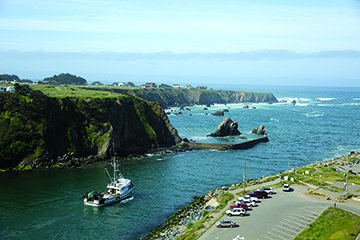Scratch shares
West Coast groundfish species are bouncing back, but choke species, loan payments and observer coverage keep fleet on the ropes
Since the catch-share program was established in 2011, groundfish on the West Coast have come back strong. After being listed as a federal disaster in 2000, rebuilt stocks are resulting in growing quotas.
“The big picture is that we’ve really seen a stellar recovery,” says Shems Jud, who coordinates catch-share programs for the Environmental Defense Fund on the Pacific Coast. “Now we need to make sure the economic recovery is just as strong.”
The West Coast groundfish fishery is made up of more than 90 species, all with different quotas and a mixture of bottom trawl, midwater trawl and fixed gear, including pots and hooks. The highest grossing species vary from year to year, but top catches often include petrale and Dover sole as well as rock cod.
Among the barriers to economic recovery in the fishery is a mixed bag of quotas, with very-low-quota species restricting harvest on abundant species. The result being an annual harvest of about 30 percent of the overall quota, which means fishermen are leaving about 70 percent of their catch in the water every year. Meanwhile, the fleet is also required to provide 100 percent observer coverage.
“We have to be the most highly regulated fishery there is,” says Geoff Bettencourt, a fourth-generation fisherman from Half Moon Bay, Calif. “We have 100 percent accountability for every fish we catch. We have huge buyback fees, huge administration fees… there are only a few of us left.”
In the lean years of the mid-2000s, the Nature Conservancy bought 13 groundfish permits and four boats in California as part of the federal effort to reduce overcapacity in the struggling fisheries, says Kate Kauer, fisheries program director with TNC.

Now the nonprofit has sold more than 90 percent of its quota to establish community fishing funds in California’s ports from Morro Bay in the south to Fort Bragg in the north, says Kauer. TNC plans to divest completely in the coming years. The fishing funds place quota in a newly established nonprofit run by fishermen and local stakeholders, the California Groundfish Collective.
“The Nature Conservancy has been very instrumental,” Bettencourt says. “Frankly we couldn’t have done it without them. If they hadn’t helped, there wouldn’t be anything.”
While environmental groups, often the enemy of commercial fishermen, have stepped in to do what the government hasn’t, some question their role as well as the catch-share program they promoted after the bottom dropped out of the fishery.
“I can’t tell you how many people they put out of business. I’m a dinosaur down here,” says Tim Athens, a commercial fisherman out of Santa Barbara, Calif. “We went from no management to over management.” The same environmental groups that killed the industry have also led the recovery, Athens laments: “We have no voice.”
Read full article in our July issue page 20.

» Read more articles in our July issue.
» Fish eNews offers the latest industry news.
» Like us on Facebook.
Copyright © 2016 National Fisherman. All rights reserved.







